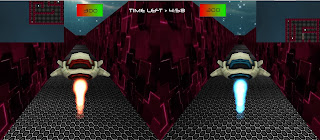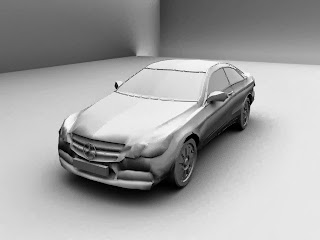Today, I will summarise what I have done for the cognitive psychology research. First of all, we have this term called "Visual Perception". This refers to the ability to recognise the surrounding environment through what we see with the help of our brain, which is our eyes. Basically, there are 2 kinds of visual perception: bottom-up processing & top-down processing.
Bottom-up processing refers to the process where information is being carried from our retina to the target to understand the target through our eyes and brain through analysis. Top-down processing refers to the process of recognising things like patterns to help in understand the main target.
The next component of the cognitive psychology is attention. Attention refers to the concentration of a specific component such that it can be processed into our brain. There are may different types of attention, but today we are only going to be talking about divided & selective attention.
Divided attention refers to focusing on 2 or more components at the same time with same amount of processing. Examples are eating while watching television programs, driving while paying attention to road signs, etc. Different people can handle different amount of tasks; some more, some less. Therefore, there is no standard limit on how many tasks they can handle. Once it reaches a certain limit, they will not be able to handle more tasks and thus, their performance and output declines.
On the other hand, selective attention is the focusing on one subject while ignoring the others. Selective attention, similarly, can be affected by certain factors, such as fatigue, brain injury, etc. Such factors can cause the person to get distracted easily as they cannot focus that well.
Next, we will be talking about memories. Memories is part of the cognitive psychology. There are many terms when it comes to memories, from short term memory to long term memory. I will be covering the basics of memories on the next part.
First of all, there's this term called "short-term memory". It refers to the information that we remembered being stored in our brain for a short while, usually about seconds. The average amount of items that can be stored at once is commonly about 7 plus or minus 2 items. Normally, short-term memory items are used together with working memory. Working memory refers to the storage of a process temporary to organise and manipulate.
The second type of memory is known as long-term memory. Long-term memory is the storage of information for a longer period of time, from as short as minutes to as long as a lifetime. Long-term memories are often associate with episodic, semantic & procedural memories. Episodic memory refers to the act of storing information of a past event and personal experience. Semantic memory refers to the storage of information based on what we have learnt or known about. Procedural memory refers to the storage of skill based information that we have learnt about.
To overcome memory loss, memory strategies can be used. As its name implies, it is the act of remembering information. There are many ways to remember lost information. The first way is through elaboration, which refers to the act of using a piece of meaningful information to help you in remembering something. Another is through self-referencing. This effect is the use of remembering related information to recall a particular information. Yet another method is distributed-practicing. This effect refers to the use of remembering a relevant information bit by bit over a period of time to obtain the main information.
The next component of cognitive psychology is mnemonics. It refers to the act of recalling memories. There are many kinds of mnemonics. Imagery mnemonics is the formation of images to recall something. Organisation mnemonics refers to the act of organising or recording information in a neat manner to recall something.
There's more to memories other than just mnemonics. Prospective memory refers to the act of remembering future, such as a task you are going to do later on. Retrospective memory refers to something to be remembered, such as people, places, etc.
So how does all of these psychology stuff relates to game design? It is related in a way that when we are creating games, every single component must be made it easy for the audience to learn and to remember its usage and functionality.
Labels
- 3D Game (3)
- 3D Models Stuff (3)
- Board Game (9)
- Flash Game (11)
- Miscellaneous (6)
- Programming (4)
- Sketches (2)
Tuesday, 3 December 2013
Monday, 2 December 2013
Concept Sketches
Below are the concept sketches I have done for my assignment for the art module. This is what I have so far.
Unity Tower Defence Game
The next assignment that was given to us right after the completion of the casual flash game is actually a 3D tower defence game. We are supposed to form a team of 3 ~ 4 members and come out with a tower defence game using Unity. My group members and I have already started this project for about 3 months and below shows the current status of the project.
Right below, it is a GUI flow chart & the game level progression flow chart, both of them are done by me.
Stay updated for more of the project!
Programming Revision
Below are some of the programming works I have done during my free time.
The below code shows the movements of the bullet when it is fired from a gun.
Below shows the codes for 4 directional scrolling.
Below shows the codes for dragging an object using a mouse. (imagine the object is a map, will it remind you of some games with this scrolling mechanics?)
Below shows the codes for enemy chasing player based on the difference between their distance.
Multiplayer Game
Below are some of the in-game screenshots of the multiplayer game. This game was also done as part of a school assignment. Similar to the puzzle game, we are required to come out with a level design and codes are provided by the lecturer.
The main objective of this game is to navigate along the maze with your partner and find the exit. Both of the players are required to reach the exit in order to win the game. Along the way, players may find themselves surrounded by enemies, puzzles and traps. Teamwork is the only option left if the player wants to beat this game.
The main objective of this game is to navigate along the maze with your partner and find the exit. Both of the players are required to reach the exit in order to win the game. Along the way, players may find themselves surrounded by enemies, puzzles and traps. Teamwork is the only option left if the player wants to beat this game.
Casual Flash Game
The casual flash game is finally completed! As part of the school assignment, the game takes me and my group months to complete it. Below are some of the screenshots of the game.
And below are some of the programming coding, as well as the game flow chart.
Year 1 Flash Game Logic
Below shows the mind map of the game logic for the side scrolling flash game.
And these are some of the programming codes for the player in the game.
Puzzle Game
Below are some of the in-game screenshots of the puzzle game that was done using unity. This was done as part of a school assignment. Programming codes were provided by the lecturer in order to guide us through the development of the game, while we (students) will need to come out with a level plan.
As shown in the pictures, player will need to navigate through this maze and find their way to the ending point. Along the way, players are required to solve puzzles, and they might find traps along their way.
As shown in the pictures, player will need to navigate through this maze and find their way to the ending point. Along the way, players are required to solve puzzles, and they might find traps along their way.
Modeling a car
Below are some of the screenshots of my already modeled car. The screenshots are listed as accordingly: model, ambient occlusion, model with texture.
Subscribe to:
Comments (Atom)


.JPG)
.JPG)
.JPG)
.JPG)














































